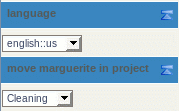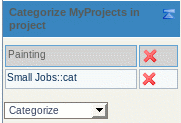Module change_category
This module allows a user to change the category of a wiki page. It is only displayed if the category feature is on and if you are on a page.
There are 3 different types of display:
- A simple display consisting of a drop down list where the current categories are selected:
This code:
Copy to clipboard{MODULE(module="change_category" id="4" title="language") /} {MODULE(module="change_category" id="8") /}
Produced:

- A display with more detail: the assigned categories are shown in a table with a button to unassign the category, and the additional categories that can be assigned are shown in the drop down list.
This code:
Copy to clipboard{MODULE(module="change_category" id="10" detail="y" categorize="categorize") /}
Produced:

- A display consisting of a combo box where you can select one or many categories from the full list of categories:
An example in http://profiles.tiki.org, once you are logged in as user, and you are in a wiki page like "r_test":
Click to expand
Parameters
Enables to categorize an object. Some combinations of Multiple categories, Detailed, Unassign and Assign may challenge intuition or be simply broken.Go to the source code
Preferences required: feature_categories, feature_wiki
| Parameters | Accepted Values | Description | Default | Since |
|---|---|---|---|---|
add |
If set to "y", allow to assign new categories. Example values: y, n. Default value: y. | |||
categorize |
String to display on the button to submit new categories, when multiple categories is enabled. Default value: Categorize. | |||
detail |
If set to "y", shows a list of categories in which the object is. If deletion is not disabled, it is done with the list. Not set by default. | |||
path |
Unless set to "n", display relative category paths in the category tree rather than category names. Paths are relative to the root category, which is not displayed. Example value: "n". Not set by default. | |||
group |
Very particular filter option. If set to "y", only categories with a name matching one of the user's groups are shown, and descendants of these matching categories. Example values: y, n. Default value: n. | |||
imgUrlIn |
Very particular parameter. If both this and "Image URL not in category" are set and the root category contains a single child category, the module only displays an image with this URL if the object is in the category. Example value: http://www.example.org/img/bigplus.png. | |||
imgUrlNotIn |
Very particular parameter. If both this and "Image URL in category" are set and the root category contains a single child category, the module only displays an image with this URL if the object is not in the category. Example value: http://www.example.org/img/redcross.png. | |||
multiple |
If set to "n", only allows categorizing in one category (from those displayed). Not set by default. | |||
notop |
In non-detailed view, disallow uncategorizing. Example value: 1. Not set by default. | |||
shy |
If set to "y", the module is not shown on pages which are not already categorized. Not set by default. | |||
del |
If set to "n", the detailed list of categories will not offer to unassign a category. Not set by default. | |||
id |
int | Changes the root of the displayed categories from default "TOP" to the category with the given identifier. Note that the root category is not displayed. Example value: 13. Defaults to 0 (root). |
Example: Use this module to toggle a category
This code:
Copy to clipboard
{MODULE(module="change_category" id="1" imgUrlNotIn="dl7" imgUrlIn="dl8" title="Statute") /}
Would produce:
And after clicking on the icon:
Tip
You can use this module multiple times on a page.
See also:
Category Transitions, PluginCategory, Module last_category_objects and Module categories
Related Pages
See these pages for information that applies for all modules:
- Module — Overall introduction and overview
- Module Admin — Introduction to the module admin pages for site-wide and individual module settings
- Assigning Modules — How to select a module to configure it
- Module Settings Interface — Interface for configuring individual module settings
- Module Settings Parameters — Explanation of standard parameter settings for modules
- Creating Custom Modules — How to create user modules
- Index of Modules — Links to the documentation of individual modules
- User Modules — How (if the feature is active) users can choose and place their modules
- Mods Type Modules — Links to modules that are installed as components